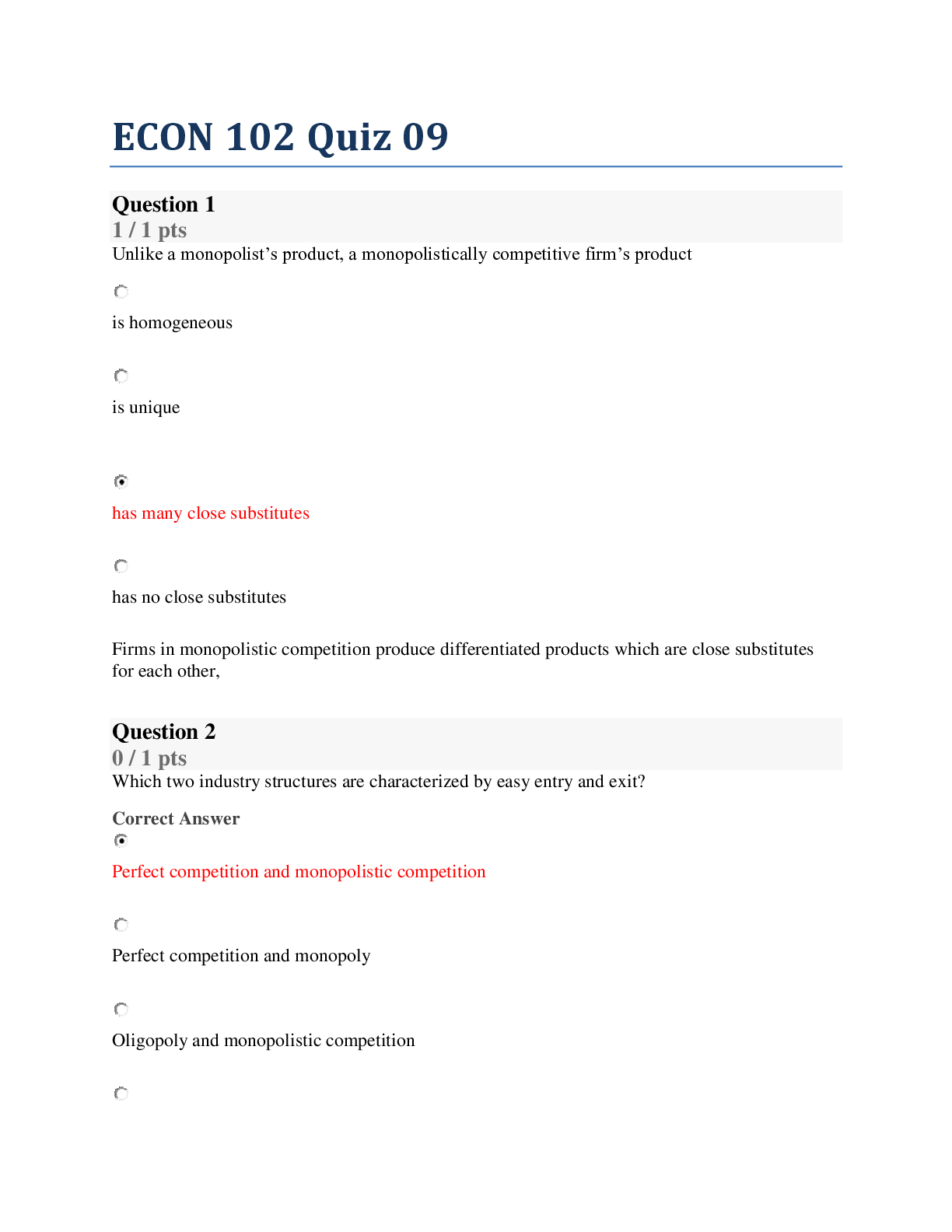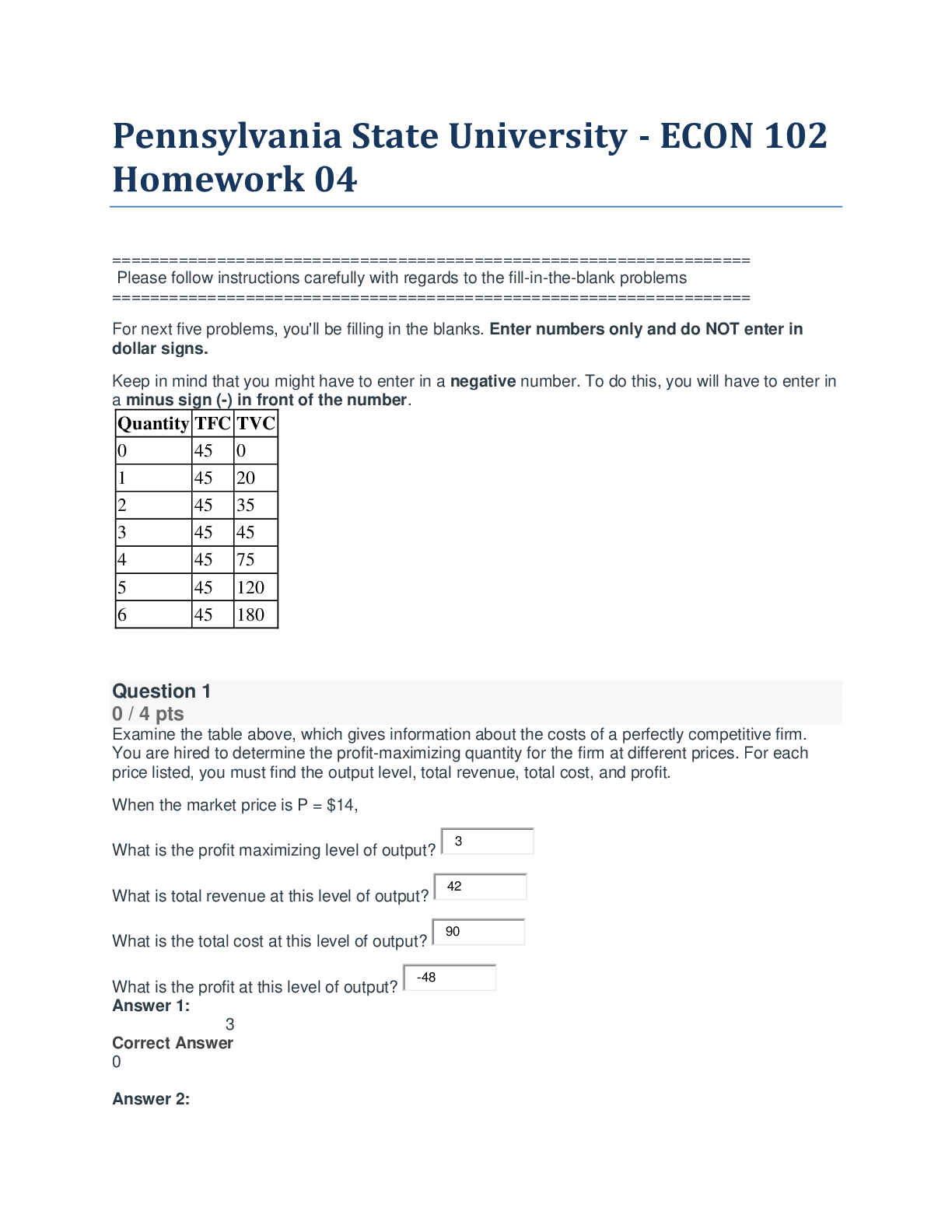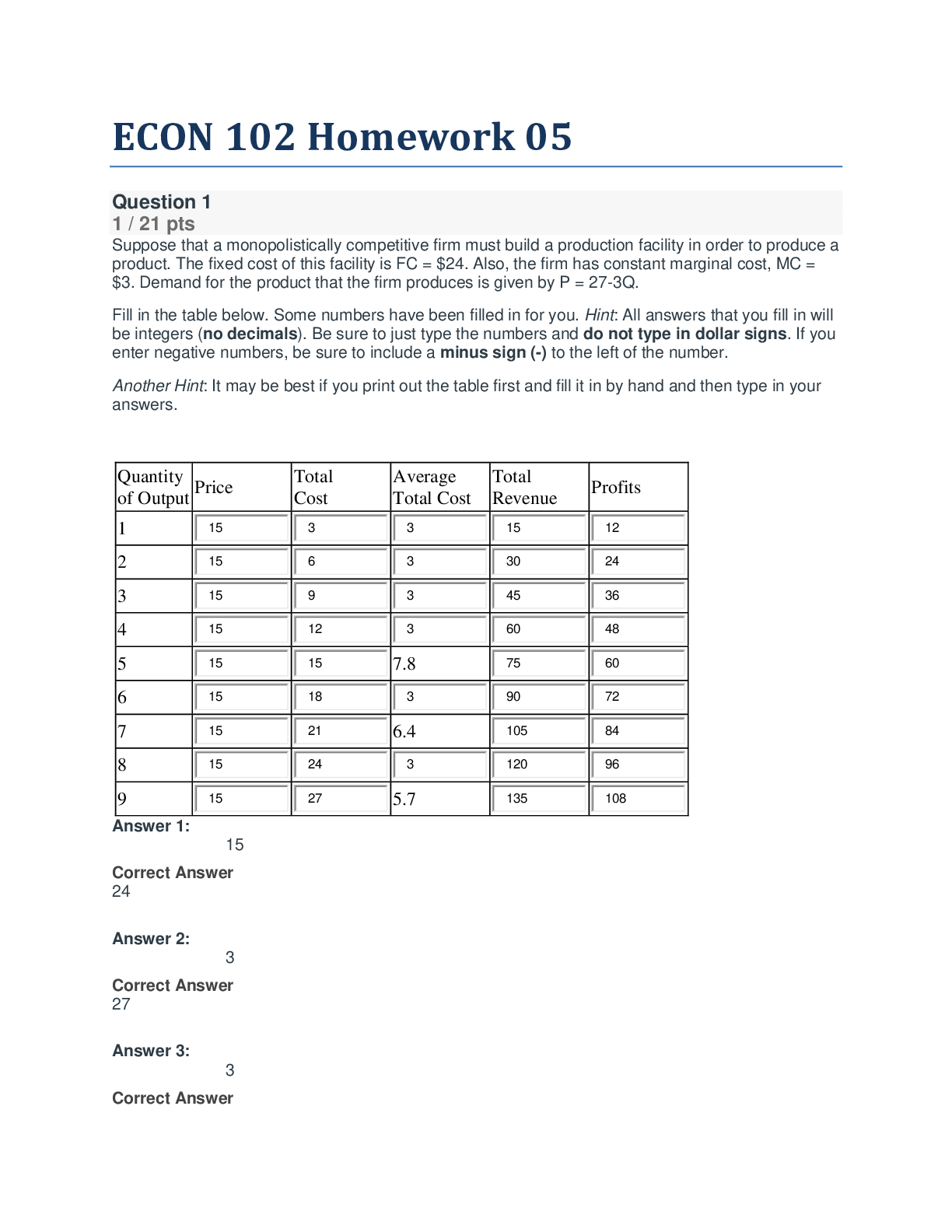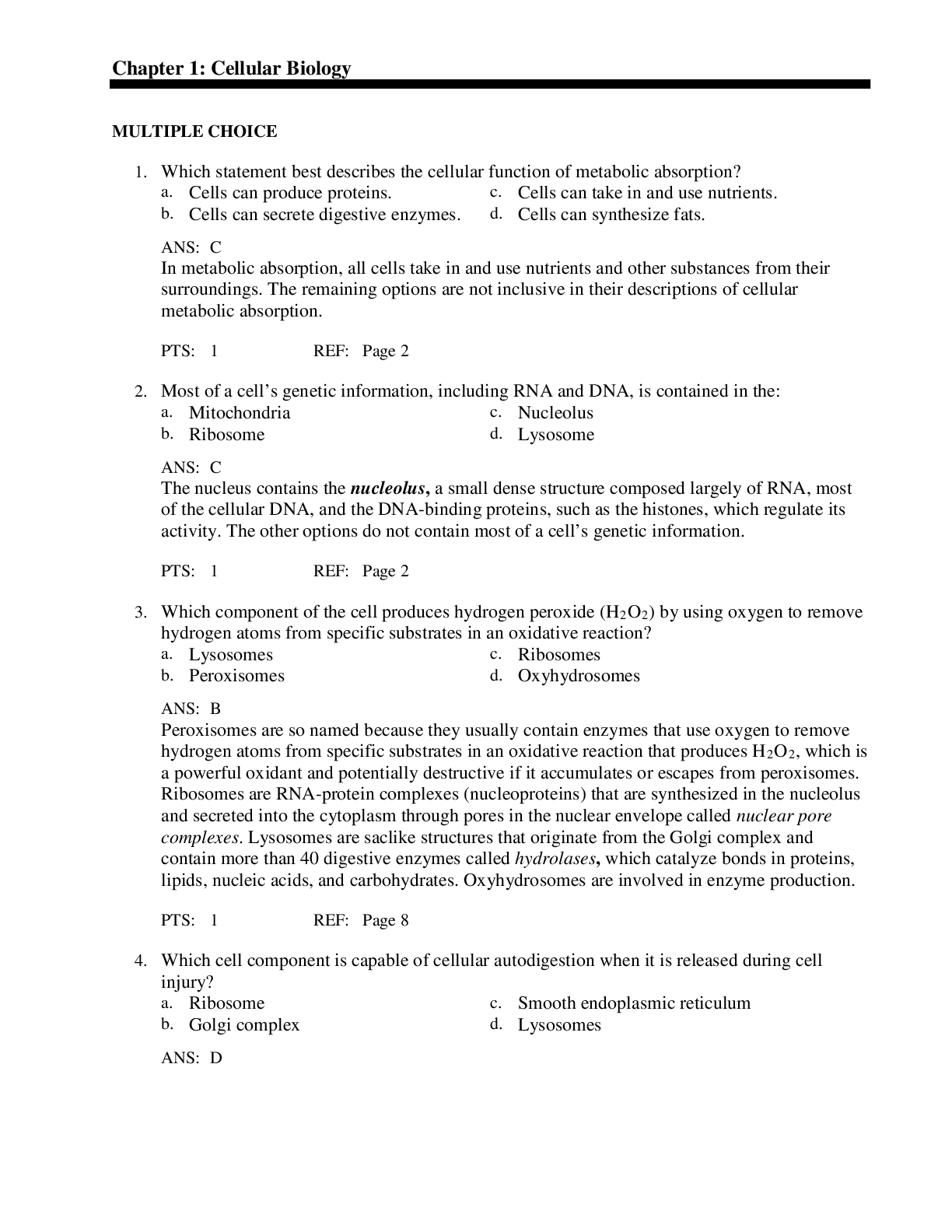*NURSING > QUESTIONS & ANSWERS > EMT Final Exam 2022 with All the Correct Answers (Actual Test graded A+) (All)
EMT Final Exam 2022 with All the Correct Answers (Actual Test graded A+)
Document Content and Description Below
EMT Final Exam 2022 with All the Correct Answers (Actual Test graded A+) 833 - Your 36 y/o pt is unresponsive upon attempting to insert an OPA, the patient gags, You should A. Insert a nasal airway... B. Suction the oropharynx C. Reattempt using a smaller oral adjunct D. Insert a dual lumen airway Correct Answer-A. Insert a nasal airway 903 - After air passes through the vocal cords during inhalation, which structure does it reach next? A. Trachea B. Epiglottis C. Alveolus D. Bronchus Correct Answer-A. Trachea 906 - You are ventilating an apneic asthmatic pt with a BVM. The patient has inadequate chest rise. You should A. Decrease the rate of ventilations to 10/min B. Use an O2 powered ventilation device C. Increase the forcefulness of ventilations D. Increase the rate of ventilations to 20/min Correct Answer-A. Decrease the rate of ventilations to 10/min 909 - A 72 y/o female pt is unresponsive following an ejection from a MVC, she has an open jaw fracture and a dialated right pupil. What is the best way to open this pt's airway A. Insert an OPA B. Perform a modified head tilt chin lift C. Insert a NPA D. Perform jaw thrust Correct Answer-C. Insert a NPA910 - A 4-Year-old female tracheostomy pt has pulled out her tracheostomy tube. The opening is partially obstructed with skin. You should A. Use a soft tip catheter and suction until clear B. Insert a nasal airway into stoma C. Wipe the area clean and perform mouth to stoma ventilation D. Cut the skin away from the stoma Correct Answer-A. Use a soft tip catheter and suction until clear 908 - You are using a BVM and an OPA on an apneic pt. Suddenly it becomes difficult to ventilate. You should first suspect that A. The patients diaphragm has contracted B. The pt has an airway obstruction C. The Pt is becoming more responsive D. The pt's lungs have collapsed Correct Answer-B. The pt has an airway obstruction 946 - A 60-year-old pt with stoma is apneic. You have been suctioning pink frothy sputum for 10 seconds and you continue to get more material. You should A. continue suctioning and have a partner ventilate through the pt's mouth B. suction until airway is clear C. stop suctioning and give a breath D. use a saline solution to moisten secretions and continue suctioning Correct Answer-C. stop suctioning and give a breath 947 - victim of smoke inhalation has developed difficulty breathing. He does not like the smell of the mask you are using to deliver O2. You should A. Switch to a NC set to deliver O2 @ 6 LPM B. Restrain the pt and continue administering O2 via NRB C. Explain that the mask is very important and continue its use D. Administer blow-by O2 via Simple mask Correct Answer-C. Explain that the mask is very important and continue its use 948 - An unresponsive 82 y/o pt is lying supine. Their airway is most likely to be obstructed byA. loose dentures B. Secretions C. The tongue D. Swelling of the epiglottis Correct Answer-C. The tongue 949 - You are inserting an OPA into a 4 y/o pt you should A. Use a tongue depressor to keep tongue out of the way B. Use a head tilt chin lift C. Insert the tip pointing toward the roof of the mouth D. Use an airway that measures one size too small and rotate Correct Answer-A. Use a tongue depressor to keep tongue out of the way 951 - Initial assessment reveals an alert adult pt who is SOB. He is seated in a tripod position using accessory muscles to breathe. Vital signs are BP 140/80 P 110, R 22 with crackles, SpO2 95%. You should A. Administer O2 via NRB B. Ventilate the pt with a BVM to slow respirations C. Administer O2 via NC D. Monitor pulse oximetry Correct Answer-A. Administer O2 via NRB 952 When suctioning a patient, you should A. Suction on the way in for no more than 5 seconds B. Suction on the way out for no more than 15 seconds C. Suction on the way in for no more than 15 seconds D. Suction on the way out for no more than 5 seconds Correct Answer-B. Suction on the way out for no more than 15 seconds 1139 - Which of the following is the most appropriate way to measure for an OPA? A. From the patient's earlobe to angle of the jaw B. From the center of pt's mouth to earlobe C. From the corner of the pt's mouth to the earlobeD. From the tip of pt's nose to earlobe Correct Answer-C. From the corner of the pt's mouth to the earlobe 1141 - How should you ventilate an apneic adult pt? A. Perform mouth to mask ventilation 12 breath per minute B. Ventilate with a flow restricted PPV at 12-20 breaths per minute C. Ventilate once every 5-6 seconds with a bag valve mask D. Ventilate once every 3 seconds with a BVM Correct Answer-C. Ventilate once every 5-6 seconds with a bag valve mask 1142 - Your pt was involved in a MVC he is unresponsive and you hear snoring respirations when he breathes. You should perform a A. Head tilt neck lift with c-spine stabilization B. Jaw thrust with c-spine stabilization C. Tongue jaw lift with c-spine stabilization D. Head tilt lift with c-spine stabilization Correct Answer-B. Jaw thrust with c-spine stabilization 1145 - A 67-year-old female is short of breath and sitting in a tripod position. She is on home oxygen and has had a productive cough over the last few days. During your exam, you note that she is wheezing and breathing with pursed lips. SPO2 is 93%. You should suspect A. Anaphylactic reaction B. Obstructive pulmonary disease C. AMI D. Pulmonary embolism Correct Answer-B. Obstructive pulmonary disease 1338 - Which of the following indicates the correct flow range and delivery percentage for NC? A. 1-6 LPM / 44% B. 10-15 LPM / 95% C. 2-8 LPM / 28% D. 2-4 LPM / 35% Correct Answer-A. 1-6 LPM / 44%1348 - Allowing for appropriate exhalation when assisting ventilations can reduce/alleviate A. The amount of air required to ventilate B. Secretions when suctioning the pt's airway C. Airway obstructions D. Gastric distention- Correct Answer-D. Gastric distention 1350 - Which of the following is TRUE about the insertion of an OPA? A. If properly inserted the OPA will keep the tongue out of the airway B. The OPA should be inserted until the flange rests below the patient's teeth C. The OPA is always rotated 360 degrees as it is inserted D. The OPA is measured between the patient earlobe and nose Correct Answer-A. If properly inserted the OPA will keep the tongue out of the airway 1351 - Which of the following statements regarding suctioning of an adult is TRUE? A. You should start ventilations if suction cannot clear the airway B. You should only suction for a max of 30 seconds C. You should insert the suction catheter only as far as you can visualize D. You should remove the suction catheter with the suction machine turned off Correct Answer-C. You should insert the suction catheter only as far as you can visualize 1352. You are called to an elderly male who is having trouble breathing. Respirations are at a rate of 24 and labored and the pt is cyanotic. Your pt is conscious but unable to speak in full sentences. Enroute to the hospital your pt goes into respiratory arrest. You should. A. use a pocket mask and begin chest compressions B. Assist ventilations with BVM and room air. C. Assist ventilations with BVM and 100% O2 D. Start oxygen at 15 LPM via NRB Correct Answer-C. Assist ventilations with BVM and 100% O2 1353 - What are two manual methods of opening a patient's airway?A. Head tilt-chin lift and NPA B. Head tilt chin lift and OPA C. Jaw thrust and finger sweep D. Head tilt and jaw thrust Correct Answer-D. Head tilt and jaw thrust 1358 - What is the amount of air moved with one normal breath called? A. Dead air space B. Minute volume C. Alveolar air D. Tidal volume Correct Answer-D. Tidal volume 1360 - What does pulse oximetry measure? A. Percent of carbon dioxide in the cells B. Percent of tissue that is saturated with oxygen C. The amount of plasma that is saturated D. The amount of hemoglobin that is saturated usually with oxygen. Correct Answer-D. The amount of hemoglobin that is saturated usually with oxygen. 1804 - When opening the airway of an unconscious pt found lying in bed you should A. Place one hand on the forehead with fingertips of the other hand pinching the nose B. Place one hand on the forehead with the other hand on the angle of the jaw C. Place the right hand on the base of the neck and left hand under the angle of the jaw and tip head backward D. Place both hands at base of neck and tip head backward to fully extend the neck. Correct Answer-B. Place one hand on the forehead with the other hand on the angle of the jaw 1807 - Your pt is pale and seems anxious but is speaking in full sentences. You should administer O2 using a A. flow restricted O2 powered ventilation device B. NRB @ 15 LPMC. NC @ 4 LPM D. BVM @ 15 LPM Correct Answer-B. NRB @ 15 LPM 1819 - Your 92 y/o pt is SOB, unable to speak, and cyanotic. You should first A. Assure the patient has an open airway B. Ventilate the pt with BVM C. Administer O2 via NRB D. Administer the prescribed bronchodilator Correct Answer-A. Assure the patient has an open airway 1820 - Your 73 y/o pt is sitting in the tripod position. As you approach they motion for assistance in using their inhaler. You should immediately A. Administer their prescribed inhaler B. Administer O2 via NRB C. Assess the pt's airway status D. Ventilate with a BVM Correct Answer-C. Assess the pt's airway status 1934 - While ventilating a near drowning pt, you suddenly feel increased resistance in the airway. You should A. Perform abdominal thrust B. Place pt in lateral recovery position C. Attempt to reposition the head D. Apply firm pressure to the abdomen Correct Answer-C. Attempt to reposition the head 8050 - For which of the following patients would an OPA be most appropriate? A. A 19 y/o with a mandible fracture who is only responsive to pain B. Unresponsive 25 y/o with a suspected spinal injury C. Unresponsive five-year-old with a suspected airway obstruction D. Semiconscious 76 y.o old who is gasping for air Correct Answer-C. Attempt to reposition the head16349 - A 24 y/o male with a history of asthma has stopped breathing. Which ventilation rate would be most appropriate? A. 30 breaths per minute B. 20 breaths per minute C. 10 breaths per minute D. 24 breaths per minute Correct Answer-C. 10 breaths per minute 16350 - A 75 y/o pt is complaining of SOB vital signs are 160/88, P 130, R 22 with crackles in the bases of the lungs. You should A. Administer O2 via mask B. Perform detailed chest assessment C. Assist the pt with prescribed inhaler D. Obtain a complete SAMPLE history Correct Answer-A. Administer O2 via mask 16361 - A 62 y/o female pt is clutching her chest inside a local restaurant. She is unable to breathe. You should A. Begin cardiopulmonary resuscitation B. Perform a blind finger sweep C. Perform a series of abdominal thrust D. Apply O2 and assess her pulse Correct Answer-C. Perform a series of abdominal thrust 16364 - When ventilating with a mouth to mask you notice the presence of increasing gastric distention. You should A. Manually reposition the airway B. Immediately suction oropharynx C. Increase the depth of ventilations D. Decompress the stomach manually Correct Answer-A. Manually reposition the airway 1155 - A malfunction of the heart's electrical system may result in A. AtherosclerosisB. Pericarditis C. Aneurysm D. Arrhythmia Correct Answer-D. Arrhythmia 1156 - All of the following are indications for the use of nitro EXCEPT A. Patient has a history of cardiac problems B. The patient's physician has prescribed nitro C. Pt complains of CP D. The pt's systolic BP is less than 90 Correct Answer-D. The pt's systolic BP is less than 90 1157 - A 60 y/o female has chest pain. She has not taken her prescribed nitro you should A> Determine what type of cardiac problem the pt has, and assist her with taking the nitro B> Immediately attached the AED and begin transport to hospital C> Administer aspirin only and withhold the nitro D> Consult medical direction with regard to assisting the pt in taking the nitro Correct Answer-A> Determine what type of cardiac problem the pt has, and assist her with taking the nitro 1268 - You have assisted a 56 y/o pt in taking 1 nitro he continues to complain of CP. Vital signs are: BP 94/64, P 120, R 14, SaO2 98%. You should A. Reassess his BP B. Assist him with a 2nd nitro C. Transport D. Assess lung sounds and have pt self-administer their inhaler Correct Answer-C. Transport 1269 - You are transporting a pt with CP, when suddenly she becomes unresponsive you should A. Start CPR and transport more rapidly B. Stop the ambulance and confirm absence of pulse C. Immediately apply an AED and analyze D. Insert an OPA and ventilate twice Correct Answer-B. Stop the ambulance and confirm absence of pulse1271 - __________________ is a cardiac arrhythmia characterized by a complete disorganization of electrical activity A. Ventricular tachycardia B. Pulseless electrical activity C. Ventricular fibrillation D. Atrial fibrillation Correct Answer-C. Ventricular fibrillation 1273 - One of the most problematic side effects of nitro is A. Hypotension B. Bradycardia C. Angina D. Dyspnea Correct Answer-A. Hypotension 1278 - The strongest portion of the heart that is responsible for circulating blood to the entire body is the A. Left atrium B. Right atrium C. Left ventricle D. Right ventricle Correct Answer-C. Left ventricle 1279 - You are dispatched to a 68 y/o female complaining of discomfort in her upper back. She is nauseous and appears to be sweaty. Based on these symptoms, which of the possible causes is most life-threatening. A. Stroke B. Diabetic reaction C. Cardiac compromise D. Indigestion Correct Answer-C. Cardiac compromise1281 - A 62 y/o female who has been drinking alcoholic beverages is feeling dizzy. She cannot walk and she complains of severe headache. You should suspect A. Delirium tremens B. Severe migraine C. Hemorrhagic stroke D. Acute alcohol intoxication ~ C. Hemorrhagic stroke 1282 - When you assess a pulse you are feeling the A. Contraction of the left atrium B. Relaxation of both ventricles C. Relaxation of the atria D. Contraction of the left ventricle Correct Answer-D. Contraction of the left ventricle 1283 - A common symptom of cardiac compromise is CP or discomfort known as A. Fibrillation B. Ischemia C. Myocardial infarction D. Angina Correct Answer-D. Angina 1284 - Your pt is a 65 y/o male CC CP, which of the following would be a contraindication for assisting with the administration of sublingual nitro? A. Heart rate <100 B. SBP >100 C. SBP <100 D. HR >100 Correct Answer-C. SBP <100 1286 - You are alone when you witness a 57 y/o woman suddenly collapse and become unresponsive. She is not breathing. After calling for help you find that she has no pulse. You should A. Begin chest compressionsB. Leave the pt and obtain an AED C. Continue rescue breathing D. Perform blind finger sweep. Correct Answer-A. Begin chest compressions 1285 - Which of the following is the build-up of fatty deposits on the inner walls of an artery? A. Coronary artery disease B. Thrombus C. Aneurysm D. Atherosclerosis Correct Answer-D. Atherosclerosis 1287 - Your pt is a 56 y/o male who collapses while mowing the lawn. He is apneic and pulseless immediately following collapse. What is the patient most likely experiencing? A. Heart attack B. Cardiac Arrest C. Angina D. Stroke Correct Answer-B. Cardiac Arrest 1288 - A 62 y/o female is complaining of crushing CP that radiates to between her shoulder blades. She is very pale, diaphoretic, and feels nauseous. You should suspect a/an A. Cardiac event B. Cerebrovascular event C. Hypoglycemic reactions D. Asthma attack Correct Answer-A. Cardiac event 1440 - A 67 y/o female just had a syncopal episode while using the toilet. Vitals are BP 100/6-. P 110 irregular, R 12. She is weak and dizzy. You should suspect a A. gastrointestinal obstruction B. vertebral vascular accident C. cardiac rhythm disturbance D. acute myocardial infarction Correct Answer-C. cardiac rhythm disturbance1763 - A pulseless and apneic 68 y/o male has an implanted pacemaker in his right shoulder. Without delaying defibrillation where should you apply the AED pads. A. Left shoulder (to avoid pacemaker) and right lower chest B. Nipple line under the left and right armpits C. Anterior chest and back (between shoulder blades) D. Right shoulder (directly over the pacemaker) and lower left chest. Correct Answer-C. Anterior chest and back (between shoulder blade 1764 - A pt becomes unresponsive. You find she is apneic and pulseless. You should A. Start CPR and apply the AED B. Apply O2 via BVM and apply the AED C. Apply AED and analyze D. Request ALS and begin CPR Correct Answer-A. Start CPR and apply the AED 1816 - Albuterol is an example of a (an) A. Vasodilator B. Vasoconstrictor C. Antihypertensive D. Beta-agonist Correct Answer-D. Beta-agonist 1818 -Administer prescribed nitro A. Place the pt on O2 B. Perform head to toe assessment- 1826 - After delivering a shock with an AED, the patient begins to move and speak. You should A. Assess vitals and begin transport B. Immediately remove the AED to avoid accidental shockC. Begin BVM ventilations D. Perform a sternal rub to assess LOC Correct Answer-A. Assess vitals and begin transport 1827 - A 56 y/o male is complaining of severe CP. He took Viagra two hours ago and has been physically active. You should A. Assist the pt in taking his nitro and apply O2 B. Administer O2 and request an ALS intercept C. Monitor vitals, if BP is above 100 systolic, administer nitro and apply oxygen D. Assure an open airway and continue gathering history Correct Answer-D. Assure an open airway and continue gathering history 1829 - You have administered six shocks to your cardiac arrest patient. She remains pulseless and is not breathing. You should next A. Deliver two more shocks B. Continue your assessment C. Reanalyze the rhythm and deliver as many shocks as indicated D. Resume CPR and transport Correct Answer-D. Resume CPR and transport 1830 - A patient complains of left sided chest discomfort. The vital signs are BP 108/68 P 104 R 24 SpO2 90% and her hands are cyanotic. You should A. Vent using BVM @ 15 LPM B. Use flow restricted PPV C. Administer O2 via NC @ 4 LPM D. Administer O2 via NRB @ 15 LPM Correct Answer-D. Administer O2 via NRB @ 15 LPM 1867 - A 45 y/o female pt complaining of left sided chest discomfort. Her vital signs are BP 108/68, P 104, R 20, and her fingers are blue. You should A. Administer oxygen by NRB 15 LPM B. Use flow restricted PPV C. Administer O2 via NC @ 4 LPMD. Ventilate using BVM @ 15 LPM Correct Answer-A. Administer oxygen by NRB 15 LPM 1869 - Your pt's pulse returns after the use of the AED. You should first A. Reanalyze the rhythm B. Continue performing compressions if BP is too low C. Turn off the AED and remove the defibrillator pads D. Continue ventilations Correct Answer-D. Continue ventilations 1883 - A 72 y/o pt is suddenly unable to speak and begins staring off towards the right. You should first A. Note the time and apply O2 B. Transport the pt in supine position C. Insert an OPA D. Administer oral glucose Correct Answer-A. Note the time and apply O2 1884 - an AED has advised no shock to be delivered to a 60 y/o pulseless and apneic pt. You should A. Leave the AED pads in place and begin CPR B. Reposition the airway and perform a finger sweep C. Turn off the AED and begin CPR immediately D. Reposition the AED pads and attempt to defibrillate Correct Answer-A. Leave the AED pads in place and begin CPR 1935 - Your pt has been submerged underwater for an unknown period and is in cardiac arrest. After taking c-spine precautions you should A. Dry the pt off B. Ventilate the pt C. Apply pressure to abdomen D. Begin CPR immediately Correct Answer-D. Begin CPR immediately 2118 - Your patient is pale, diaphoretic, and complains of chest pressure. Her vitals are R 18 P 58, and BP 88/50. You should suspectA. Unstable angina B. A thoracic aneurysm C. Cardiogenic shock D. Pulmonary embolism Correct Answer-C. Cardiogenic shock [Show More]
Last updated: 2 years ago
Preview 1 out of 48 pages
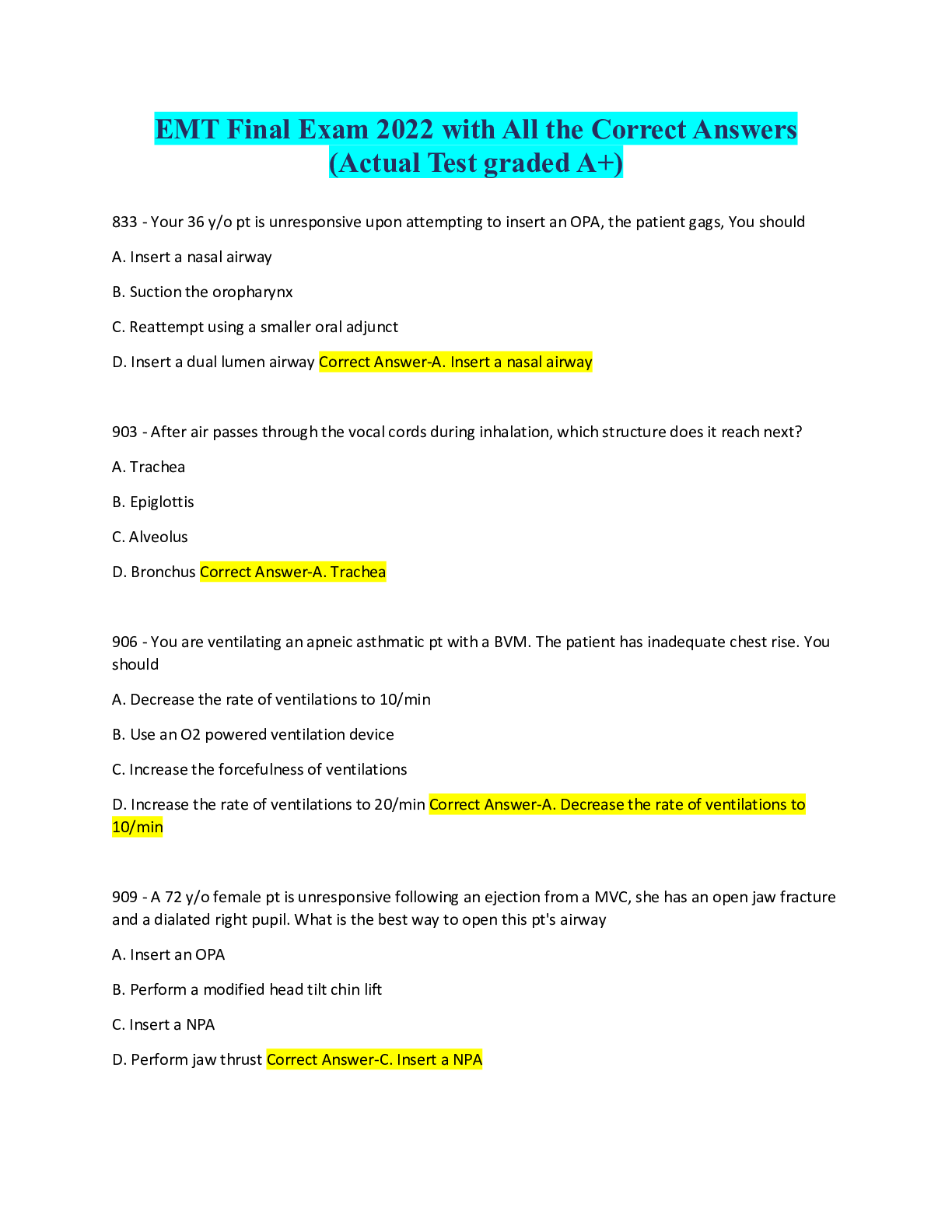
Buy this document to get the full access instantly
Instant Download Access after purchase
Buy NowInstant download
We Accept:

Reviews( 0 )
$8.00
Can't find what you want? Try our AI powered Search
Document information
Connected school, study & course
About the document
Uploaded On
Sep 08, 2022
Number of pages
48
Written in
Seller

Reviews Received
Additional information
This document has been written for:
Uploaded
Sep 08, 2022
Downloads
0
Views
164

















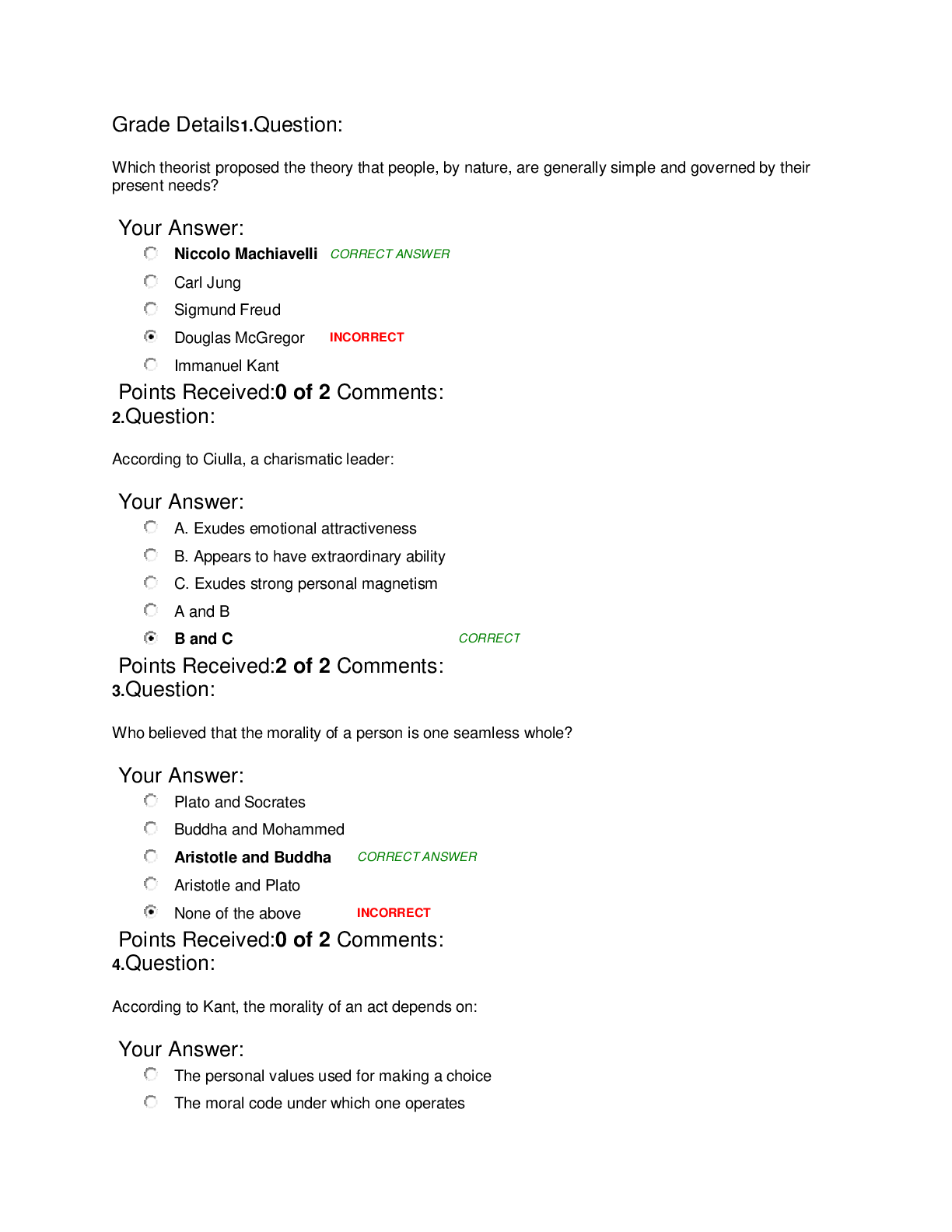

.png)
